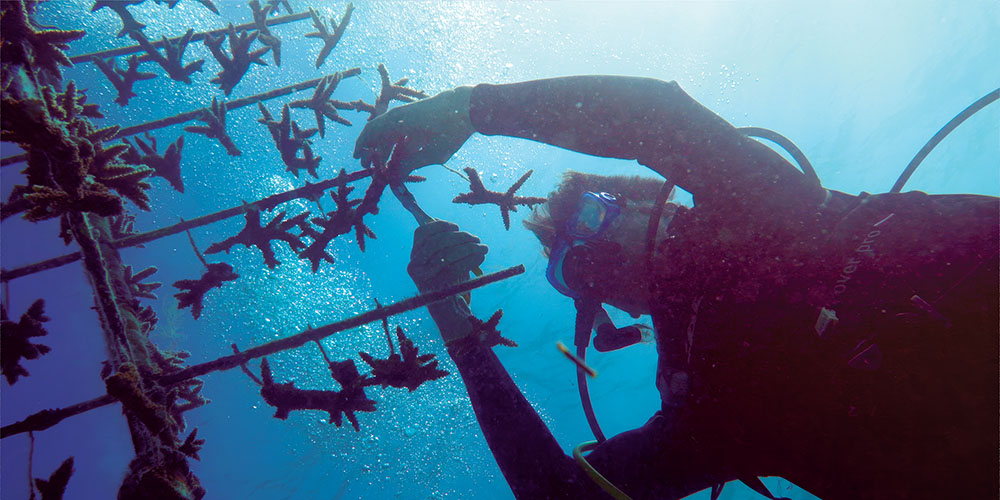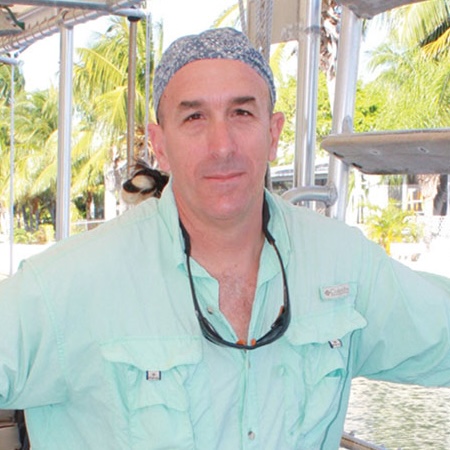
How Can Coral Outplanting Save the Florida Keys Reef Tract?
By Katie Garwood
From the time he was a child, Dr. Dan McCarthy has been fascinated with coral reefs. The way they shelter numerous aquatic organisms and protect them from predators, their various shapes and sizes, and how they create biodiversity -- it's no wonder that McCarthy has spent nearly the past 30 years studying them.
For the past two decades, McCarthy, who serves as a professor of biology and marine science as well as director of the MSC undergraduate program, has been taking groups of students to the Florida Keys to share his passion with them, while introducing them to another aspect of his research: coral reef restoration.
It’s an especially important task, as reefs worldwide are facing threats from climate change and pollution. In the Florida Keys, where McCarthy’s restoration work is focused, disease and warming waters have endangered the health of the coral population. The Florida Keys Reef Tract is the only one in the U.S., and it is crucial to providing habitat for various organisms and protecting the shorelines from storm surges.
“When I introduce myself to students, I call myself a reef guy,” McCarthy said. “It’s
not just coral reefs, but it’s also oyster reefs and these shallow water reefs that are along the east coast of
Florida.”
also oyster reefs and these shallow water reefs that are along the east coast of
Florida.”
McCarthy took the most recent student group down to the lower Florida Keys in April of 2024. The group included undergraduate and graduate students from a cross-listed coral reef ecology and management class he taught that semester. It also included members of JU’s student dive club, the Dolphin Divers. Together, the JU team worked at the Boy Scouts of America land-based nursery using a diamond saw to microfragment more than 100 corals that will eventually be placed on a degraded reef. The students used scuba to observe the health of one of the Keys’ largest coral reefs: Looe Key. They also went diving on a coral outplant nursery offshore, where they cleaned the areas surrounding numerous corals to help promote their survival. Mote Marine Laboratory, which oversees that area, thanked the group on social media for their help.
With the microfragmentation technique, a large coral is cut into pieces using a diamond blade saw, which stimulates their growth, allowing them to grow much more quickly than they normally would. In the lab, the students cut the corals into pieces, then they take the fragmented corals and outplant them onto reefs to bring coral life back into struggling reef ecosystems.
“I also find the restoration side of things — putting the corals out there and looking at their survival and seeing a lot of good survival — very gratifying,” McCarthy said. “There are corals that I’ve put out roughly seven years ago that are still there today, so I feel like they wouldn’t be here if we didn’t put them out there. I’m trying to pass on that experience to JU students as well.”
Dr. Anthony Ouellette, a professor of biology and chemistry, heard about McCarthy’s trips to the Keys about seven years ago and, like the dozens of students who’ve traveled south with McCarthy over the years, was immediately fascinated by the idea. He asked to join one of their trips so he could film a brief video of what the students were working on.
For a biology professor with a longtime passion for cameras and capturing the natural world, the project was a perfect fit. Ouellette earned his scuba diving certification, which enabled him to dive with the students to gather footage and also help restore corals himself.
Seven years later, Ouellette still travels to the Keys with McCarthy and now is in the final stages of completing a documentary on McCarthy and his students’ research and restoration efforts in the Florida Keys.
“I got so wrapped up and really enamored with what they were doing, and, talking to the people involved, talking to the director of the program down there, talking to the interns and to the nursery manager, everybody was just so into it,” Ouellette said. “And you can kind of just feel an undercurrent of energy there. What they were doing clearly mattered to them.”
Over the years, McCarthy has facilitated collaborations with several groups involved in coral reef restoration, including the Mote Marine Laboratory, Plant a Million Corals and the Boy Scouts of America Sea Base.
McCarthy has plans to bring more students to the Keys and ultimately wants to continue to grow the program by increasing student participation and partnering with more organizations working on coral reef restoration.
“There’s a collaboration with a number of different state, federal and some private groups to help restore seven of the major reefs in the Florida Keys,” McCarthy said. “It’s called Mission: Iconic Reefs, and I’ve been in contact with them about ways that we might be able to contribute to what they’re doing. It’s a pretty hefty project, what they’re trying to do with restoring these reefs. I’m hoping that we can be a part of that in the future.”
And while their methods are slightly different, with McCarthy focusing on the science behind coral reef restoration and Ouellette telling the story, their goals are aligned: to raise awareness and inspire others to make a difference in our coral reef environments. “I want kids all around, even in the middle of America, where people aren’t scuba diving, to watch it and say ‘I can do that,’” Ouellette said. “I want people to be inspired to do something.”
